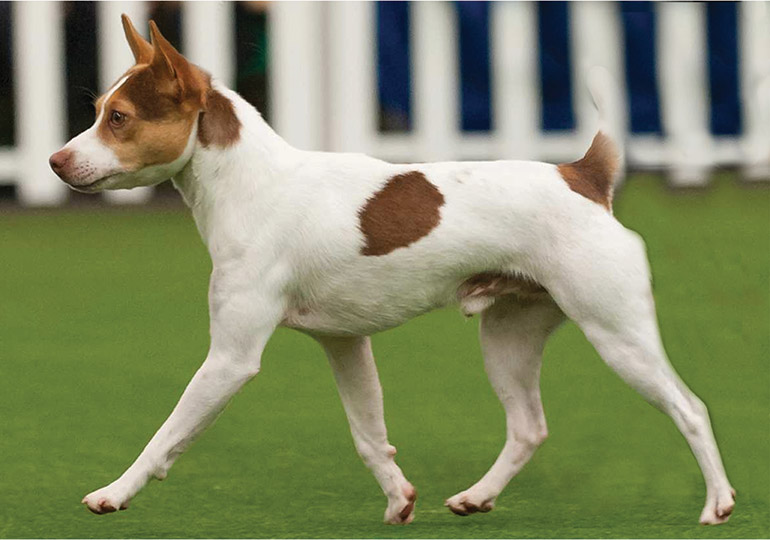Breeds
Tenterfield Terrier

GROUP 2 - TERRIERS
History
The Tenterfield Terrier’s relationship with Aussies began when early English settlers arrived with the original working dog of the breed.
They were bred small enough to chase vermin out of burrows, but with the strength and agility to jump up onto a horse’s saddle with their master. Together, they would ride the chase after bringing the rats, rabbits and foxes out of hiding. The breed spread across Australian farmland and became a popular working Terrier and a loyal part of many families.
Affectionately known as the mini foxy at the time, the Tenterfield Terrier became an Aussie icon on most farms. While the title mini foxy was accepted for quite some time, given that the breed is not a miniature of the Fox Terrier, the name was inappropriate and it caused some confusion as the two are quite different. Therefore, after the breed was developed to the type it is today, dedicated breeders and enthusiasts established the name Tenterfield Terrier.
The breed was named after another Australian icon, Peter Allen’s grandfather, the ‘Tenterfield Saddler’. Well known for owning and breeding Tenterfield Terriers, he was regularly seen in his home town with his Terriers by his side. It was decided the name would therefore be fitting for a true Aussie breed.
Characteristics
The Tenterfield Terriers have strength beyond their small stature. They are active, extremely agile, very intelligent and highly adaptable to a variety of situations. They are just as happy roaming farmland working to rid their territory of vermin as they are curled up on a lap or playing with a toy in a small apartment.
Maintenance
When it comes to caring for Tenterfield Terriers, they don’t come much easier. A simple ‘wash and wear’ is all that’s required, and the coat will need an occasional brush. If they are being shown, a trim of any untidy bits is recommended and the rest is standard dog maintenance, including trimming nails, cleaning teeth and deworming.
Appearance
Tenterfields are ideally 25.5 to 30.5 centimetres high (10 to 12 inches) at the top of the shoulder with an appropriate weight for the overall size. They should appear square, with a balance between the length of the body and leg. The head and neck length should also be balanced. Proportion-wise, no one thing should stand out, with the exception of the bob tail in dogs where it occurs. As the only Terrier with the natural bob tail gene, this is the Tenterfield’s most unique feature, and tails of all length should be carried gaily and not hanging down or curled right over. The ears should be alert and a Tenterfield’s eyes should be as dark brown as possible, with a keen expression. Lighter eyes are acceptable in a liver. The Tenterfield Terrier is always smooth and single coated. Colouring is predominantly white with black, tan or liver markings with the tricolour being the most common.
Health & Suitability
Tenterfield Terriers are known for living a long life of anywhere from 12 to 20 years, with no major health issues.
Congenital hypothyroidism with goitre has been associated with the breed and more recently primary lens luxation. The national Tenterfield community is taking action to protect the breed, including testing to prevent affected puppies being produced. Tenterfields are suitable for all types of people from the elderly to young children and are very compatible with other pets if introduced as a puppy.
They can endure many miles of walking, if the owner enjoys being active, and are equally happy living indoors or out – making them a truly versatile breed. Tenterfield Terriers are also well suited to sporting events such as Agility, Lure Racing, Flyball and Earthdog. True to Terrier form, they will defend themselves if feeling threatened.
Some people have misinterpreted a Tenterfield Terrier’s vocal enthusiasm as aggression, but they’re generally not in any way hostile. If well socialised there should be no issues and overall they are very affectionate.
Words: Paula Stirzaker
Image: Selectadogbreed
In Conclusion
Now you know a little about the Tenterfield Terrier, you may think that this is the dog for you. Before you make a decision, please make contact with the breed club or your State controlling body for purebred dogs. They will be able to give you information about available puppies and also suggest dog shows where you can see the breed and speak to breeders. In this way you will gain a better perspective of the Tenterfield Terrier and its needs, and whether this breed would suit your lifestyle.
Breeders



